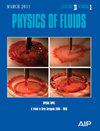Pressure and partial wetting effects on superhydrophobic friction reduction in microchannel flow
IF 4.1
2区 工程技术
Q1 MECHANICS
引用次数: 57
Abstract
Friction reduction in microchannel flows can help alleviate the inherently taxing pumping power requirements associated with the dimensions involved. One possible way of achieving friction reduction is through the introduction of surface microtexturing that can lead to a superhydrophobic Cassie-Baxter state. The Cassie-Baxter state is characterized by the presence of air pockets within the surface microtexturing believed to act as an effective “shear free” (or at least shear reduced) layer, decreasing the overall friction characteristics of the surface. Most work in this area has concentrated on optimizing the surface microtexturing geometry to maximize the friction reduction effects and overall stability of the Cassie-Baxter state. However, less attention has been paid to the effects of partially wetted conditions induced by pressure and the correlation between the liquid-gas interface location within the surface microtexturing and the microchannel flow characteristics. This is mainly attributed to the difficulty in tracking the interface shape and location within the microtexturing in the typical top-down view arrangements used in most studies. In this paper, a rectangular microchannel with regular microtexturing on the sidewalls is used to visualize and track the location of the air-water interface within the roughness elements. While visually tracking the wetting conditions in the microtextures, pressure drops versus flow rates for each microchannel are measured and analyzed in terms of the non-dimensional friction coefficient. The frictional behavior of the Poiseuille flow suggests that (1) the air-water interface more closely resembles a no-slip boundary rather than a shear-free one, (2) the friction is rather insensitive to the degree of microtexturing wetting, and (3) the fully wetted (Wenzel state) microtexturing provides lower friction than the non-wetted one (Cassie state), in corroboration with observations (1) and (2).微通道流动中压力和部分润湿对超疏水摩擦减少的影响
微通道流动中的摩擦减少有助于减轻与所涉及的尺寸相关的固有的繁重的泵送功率要求。实现减少摩擦的一种可能方法是通过引入表面微纹理,从而导致超疏水Cassie-Baxter状态。Cassie-Baxter状态的特点是表面微纹理中存在气囊,被认为是有效的“无剪切”(或至少减少剪切)层,降低了表面的整体摩擦特性。该领域的大部分工作都集中在优化表面微纹理几何形状,以最大限度地减少摩擦效果和Cassie-Baxter状态的整体稳定性。然而,对压力引起的部分湿润条件的影响以及表面微织构内液气界面位置与微通道流动特性之间的关系关注较少。这主要是由于在大多数研究中使用的典型的自上而下的视图排列中,难以跟踪微纹理内的界面形状和位置。在本文中,采用矩形微通道,在侧壁上有规则的微纹理,用于可视化和跟踪粗糙度元素中空气-水界面的位置。在视觉上跟踪微纹理中的润湿条件的同时,根据无量纲摩擦系数测量和分析了每个微通道的压降与流速。泊泽维尔流动的摩擦行为表明:(1)空气-水界面更接近于无滑移边界,而不是无剪切边界;(2)摩擦对微织构润湿程度相当不敏感;(3)完全润湿(Wenzel状态)微织构提供的摩擦比未润湿(Cassie状态)低,这与观察结果(1)和(2)相吻合。
本文章由计算机程序翻译,如有差异,请以英文原文为准。
求助全文
约1分钟内获得全文
求助全文
来源期刊

Physics of Fluids
物理-力学
CiteScore
6.50
自引率
41.30%
发文量
2063
审稿时长
2.6 months
期刊介绍:
Physics of Fluids (PoF) is a preeminent journal devoted to publishing original theoretical, computational, and experimental contributions to the understanding of the dynamics of gases, liquids, and complex or multiphase fluids. Topics published in PoF are diverse and reflect the most important subjects in fluid dynamics, including, but not limited to:
-Acoustics
-Aerospace and aeronautical flow
-Astrophysical flow
-Biofluid mechanics
-Cavitation and cavitating flows
-Combustion flows
-Complex fluids
-Compressible flow
-Computational fluid dynamics
-Contact lines
-Continuum mechanics
-Convection
-Cryogenic flow
-Droplets
-Electrical and magnetic effects in fluid flow
-Foam, bubble, and film mechanics
-Flow control
-Flow instability and transition
-Flow orientation and anisotropy
-Flows with other transport phenomena
-Flows with complex boundary conditions
-Flow visualization
-Fluid mechanics
-Fluid physical properties
-Fluid–structure interactions
-Free surface flows
-Geophysical flow
-Interfacial flow
-Knudsen flow
-Laminar flow
-Liquid crystals
-Mathematics of fluids
-Micro- and nanofluid mechanics
-Mixing
-Molecular theory
-Nanofluidics
-Particulate, multiphase, and granular flow
-Processing flows
-Relativistic fluid mechanics
-Rotating flows
-Shock wave phenomena
-Soft matter
-Stratified flows
-Supercritical fluids
-Superfluidity
-Thermodynamics of flow systems
-Transonic flow
-Turbulent flow
-Viscous and non-Newtonian flow
-Viscoelasticity
-Vortex dynamics
-Waves
 求助内容:
求助内容: 应助结果提醒方式:
应助结果提醒方式:


